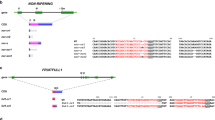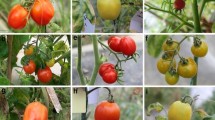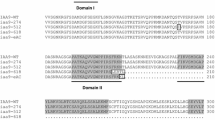Abstract
Fruit shelf life is an important tomato breeding trait. Ethylene production greatly affects shelf life and is genetically regulated. Tomato ripening is associated with increased ethylene production, and tomato is used as a model for studying fruit ripening, particularly the ethylene biosynthesis and signaling pathways. The key ripening regulator NOR encodes a NAC domain transcription factor which is part of a large plant-specific gene family. Both CRES-T and RNAi gene suppression transgenic lines revealed delayed ripening signs. Further screening of the Micro-Tom ethyl methanesulfonate (EMS)-mutagenized population enabled the selection of alleles responsible for phenotype alterations. Analyses of the transcription levels of ethylene biosynthesis genes ACC synthase (ACS) and ACC-oxidase (ACO) revealed that reduced ethylene production was largely due to transcriptional suppression of ACO1 and ACO3. ACO failed to oxidize the ethylene precursor, thus producing a non-climacteric phenotype in nor. Evidence indicated possible feedback regulation of NOR and cross-regulation of NOR-like genes, and functional conservation suggests that NAC coding genes may undergo functional differentiation. NOR plays a major role in ripening control, whereas NOR-like genes have a minor role; however, a better understanding of NOR-like genes could provide insights into the complex transcriptional regulation of fruit ripening.





Similar content being viewed by others
References
Alexander L, Grierson D (2002) Ethylene biosynthesis and action in tomato: a model for climacteric fruit ripening. J Exp Bot 53(377):2039–2055. https://doi.org/10.1093/jxb/erf072
Anjanasree KN, Verma PK, Bansal KC (2005) Differential expression of tomato ACC oxidase gene family in relation to fruit ripening. Curr Sci India 89(8):1394–1399
Barry CS, Giovannoni JJ (2006) Ripening in the tomato Green-ripe mutant is inhibited by ectopic expression of a protein that disrupts ethylene signaling. Proc Natl Acad Sci USA 103(20):7923–7928. https://doi.org/10.1073/pnas.0602319103
Barry CS, Giovannoni JJ (2007) Ethylene and fruit ripening. J Plant Growth Regul 26(2):143–159. https://doi.org/10.1007/s00344-007-9002-y
Barry CS, Blume B, Bouzayen M, Cooper W, Hamilton AJ, Grierson D (1996a) Differential expression of the 1-aminocyclopropane-1-carboxylate oxidase gene family of tomato. Plant J 9(4):525–535. https://doi.org/10.1046/j.1365-313X.1996.09040525.x
Barry CS, Blume B, Bouzayen M, Cooper W, Hamilton AJ, Grierson D (1996b) Differential expression of the 1-aminocyclopropane-1-carboxylate oxidase gene family of tomato. Plant J 9(4):525–535
Brecht JK (1987) Locular gel formation in develo** tomato fruit and the initiation of ethylene production. Hortscience 22(3):476–479
Cardenas FDR, Suarez YR, Rangel RMC, Garcia VL, Aguilera KLG, Martinez NM, de Folter S (2017) Effect of constitutive miR164 expression on plant morphology and fruit development in Arabidopsis and tomato. Agronomy-Basel. https://doi.org/10.3390/agronomy7030048
Cherian S, Figueroa CR, Nair H (2014) ‘Movers and shakers’ in the regulation of fruit ripening: a cross-dissection of climacteric versus non-climacteric fruit. J Exp Bot 65(17):4705–4722. https://doi.org/10.1093/jxb/eru280
Du MM, Zhai QZ, Deng L, Li SY, Li HS, Yan LH, Huang Z, Wang B, Jiang HL, Huang TT, Li CB, Wei JN, Kang L, Li JF, Lia CY (2014) Closely related NAC transcription factors of tomato differentially regulate stomatal closure and reopening during pathogen attack. Plant Cell 26(7):3167–3184. https://doi.org/10.1105/tpc.114.128272
Ernst HA, Olsen AN, Skriver K, Larsen S, Lo Leggio L (2004) Structure of the conserved domain of ANAC, a member of the NAC family of transcription factors. EMBO Rep 5(3):297–303. https://doi.org/10.1038/sj.embor.7400093
Force A, Lynch M, Pickett FB, Amores A, Yan YL, Postlethwait J (1999) Preservation of duplicate genes by complementary, degenerative mutations. Genetics 151(4):1531–1545
Fujisawa M, Shima Y, Higuchi N, Nakano T, Koyama Y, Kasumi T, Ito Y (2012) Direct targets of the tomato-ripening regulator RIN identified by transcriptome and chromatin immunoprecipitation analyses. Planta 235(6):1107–1122. https://doi.org/10.1007/s00425-011-1561-2
Fujisawa M, Nakano T, Shima Y, Ito Y (2013) A large-scale identification of direct targets of the tomato MADS box transcription factor RIPENING INHIBITOR reveals the regulation of fruit ripening. Plant Cell 25(2):371–386. https://doi.org/10.1105/tpc.112.108118
Giovannoni JJ (2004) Genetic regulation of fruit development and ripening. Plant Cell 16:S170–S180. https://doi.org/10.1105/tpc.019158
Giovannoni JJ (2007) Fruit ripening mutants yield insights into ripening control. Curr Opin Plant Biol 10(3):283–289. https://doi.org/10.1016/j.pbi.2007.04.008
Giovannoni JJ, Noensie EN, Ruezinsky DM, Lu XH, Tracy SL, Ganal MW, Martin GB, Pillen K, Alpert K, Tanksley SD (1995) Molecular-genetic analysis of the ripening-inhibitor and non-ripening loci of tomato—a first step in genetic map-based cloning of fruit ripening genes. Mol Gen Genet 248(2):195–206. https://doi.org/10.1007/Bf02190801
Griffiths A, Barry C, Alpuche-Solis AG, Grierson D (1999) Ethylene and developmental signals regulate expression of lipoxygenase genes during tomato fruit ripening. J Exp Bot 50(335):793–798. doi:https://doi.org/10.1093/jexbot/50.335.793
Han QQ, Song YZ, Zhang JY, Liu LF (2014) Studies on the role of the SlNAC3 gene in regulating seed development in tomato (Solanum lycopersicum). J Hortic Sci Biotechnol 89(4):423–429. doi:https://doi.org/10.1080/14620316.2014.11513101
Huang WZ, Miao M, Kud JN, Niu XL, Ouyang B, Zhang JH, Ye ZB, Kuhl JC, Liu YS, **ao FM (2013) SlNAC1, a stress-related transcription factor, is fine-tuned on both the transcriptional and the post-translational level. N Phytol 197(4):1214–1224. https://doi.org/10.1111/nph.12096
Jafari Z, Haddad R, Hosseini R, Garoosi G (2013) Cloning, identification and expression analysis of ACC oxidase gene involved in ethylene production pathway. Mol Biol Rep 40(2):1341–1350. https://doi.org/10.1007/s11033-012-2178-7
Jiang YM, Fu JR (2000) Ethylene regulation of fruit ripening: molecular aspects. Plant Growth Regul 30(3):193–200. https://doi.org/10.1023/A:1006348627110
Karlova R, Chapman N, David K, Angenent GC, Seymour GB, de Maagd RA (2014) Transcriptional control of fleshy fruit development and ripening. J Exp Bot 65(16):4527–4541. https://doi.org/10.1093/jxb/eru316
Kou XH, Wang S, Wu MS, Guo RZ, Xue ZH, Meng N, Tao XM, Chen MM, Zhang YF (2014) Molecular characterization and expression analysis of NAC family transcription factors in tomato. Plant Mol Biol Rep 32(2):501–516. https://doi.org/10.1007/s11105-013-0655-3
Kou XH, Liu C, Han LH, Wang S, Xue ZH (2016) NAC transcription factors play an important role in ethylene biosynthesis, reception and signaling of tomato fruit ripening. Mol Genet Genomics 291(3):1205–1217. https://doi.org/10.1007/s00438-016-1177-0
Kou XH, Mao CY, Wu MS, Han LH, Liu C, Jiang BL, Xue ZH (2017) Divergent functions of SNAC4-9 and possible mechanisms for tomato adaptation to abiotic stresses. J Hortic Sci Biotechnol 92(1):11–24. https://doi.org/10.1080/14620316.2016.1213141
Li JY, Tao XY, Li L, Mao LC, Luo ZS, Khan ZU, Ying TJ (2016) Comprehensive RNA-Seq analysis on the regulation of tomato ripening by exogenous auxin. PLoS ONE. https://doi.org/10.1371/journal.pone.0156453
Liang XQ, Ma NN, Wang GD, Meng X, Ai XZ, Meng QW (2015) Suppression of SlNAC1 reduces heat resistance in tomato plants. Biol Plant 59(1):92–98. https://doi.org/10.1007/s10535-014-0477-7
Liu ZM, Yue MM, Yang DY, Zhu SB, Ma NN, Meng QW (2017) Over-expression of SlJA2 decreased heat tolerance of transgenic tobacco plants via salicylic acid pathway. Plant Cell Rep 36(4):529–542. https://doi.org/10.1007/s00299-017-2100-9
Livak KJ, Schmittgen TD (2001) Analysis of relative gene expression data using real-time quantitative PCR and the 2−∆∆CT method. Methods 25(4):402–408. https://doi.org/10.1006/meth.2001.1262
Ma NN, Feng HL, Meng X, Li D, Yang DY, Wu CG, Meng QW (2014) Overexpression of tomato SlNAC1 transcription factor alters fruit pigmentation and softening. BMC Plant Biol. https://doi.org/10.1186/s12870-014-0351-y
Manning K, Tor M, Poole M, Hong Y, Thompson AJ, King GJ, Giovannoni JJ, Seymour GB (2006) A naturally occurring epigenetic mutation in a gene encoding an SBP-box transcription factor inhibits tomato fruit ripening. Nat Genet 38(8):948–952. https://doi.org/10.1038/ng1841
Martel C, Vrebalov J, Tafelmeyer P, Giovannoni JJ (2011) The tomato MADS-box transcription factor RIPENING INHIBITOR interacts with promoters involved in numerous ripening processes in a COLORLESS NONRIPENING-dependent manner. Plant Physiol 157(3):1568–1579. https://doi.org/10.1104/pp.111.181107
McCallum CM, Comai L, Greene EA, Henikoff S (2000) Targeting induced local lesions in genomes (TILLING) for plant functional genomics. Plant Physiol 123(2):439–442. https://doi.org/10.1104/pp.123.2.439
Mitsuda N, Matsui K, Ikeda M, Nakata M, Oshima Y, Nagatoshi Y, Ohme-Takagi M (2011) CRES-T, an effective gene silencing system utilizing chimeric repressors. Methods Mol Biol 754:87–105. https://doi.org/10.1007/978-1-61779-154-3_5
Murashige T, Skoog F (1962) A revised medium for rapid growth and bio assays with tobacco tissue cultures. Physiol Plant 15(3):473–497. https://doi.org/10.1111/j.1399-3054.1962.tb08052.x
Nakatsuka A, Shiomi S, Kubo Y, Inaba A (1997) Expression and internal feedback regulation of ACC synthase and ACC oxidase genes in ripening tomato fruit. Plant Cell Physiol 38(10):1103–1110. doi:https://doi.org/10.1093/oxfordjournals.pcp.a029094
Okabe Y, Ariizumi T (2016) Mutant resources and TILLING platforms in tomato research. Biotechnol Agric For 70:75–91. https://doi.org/10.1007/978-3-662-48535-4_6
Okabe Y, Asamizu E, Saito T, Matsukura C, Ariizumi T, Bres C, Rothan C, Mizoguchi T, Ezura H (2011) Tomato TILLING technology: development of a reverse genetics tool for the efficient isolation of mutants from Micro-Tom mutant libraries. Plant Cell Physiol 52(11):1994–2005. https://doi.org/10.1093/pcp/pcr134
Okabe Y, Asamizu E, Ariizumi T, Shirasawa K, Tabata S, Ezura H (2012) Availability of Micro-Tom mutant library combined with TILLING in molecular breeding of tomato fruit shelf-life. Breed Sci 62(2):202–208. https://doi.org/10.1270/jsbbs.62.202
Okabe Y, Ariizumi T, Ezura H (2013) Updating the Micro-Tom TILLING platform. Breed Sci 63(1):42–48. https://doi.org/10.1270/jsbbs.63.42
Osorio S, Alba R, Damasceno CMB, Lopez-Casado G, Lohse M, Zanor MI, Tohge T, Usadel B, Rose JKC, Fei ZJ, Giovannoni JJ, Fernie AR (2011) Systems biology of tomato fruit development: combined transcript, protein, and metabolite analysis of tomato transcription factor (nor, rin) and ethylene receptor (Nr) mutants reveals novel regulatory interactions. Plant Physiol 157(1):405–425. https://doi.org/10.1104/pp.111.175463
Pereira-Santana A, Alcaraz LD, Castano E, Sanchez-Calderon L, Sanchez-Teyer F, Rodriguez-Zapata L (2015) Comparative genomics of NAC transcriptional factors in angiosperms: implications for the adaptation and diversification of flowering plants. PLoS ONE. https://doi.org/10.1371/journal.pone.0141866
Prasanna V, Prabha TN, Tharanathan RN (2007) Fruit ripening phenomena—an overview. Crit Rev Food Sci 47(1):1–19. https://doi.org/10.1080/10408390600976841
Rychlik W (2007) OLIGO 7 primer analysis software. Methods Mol Biol 402:35–60. https://doi.org/10.1007/978-1-59745-528-2_2
Saito T, Ariizumi T, Okabe Y, Asamizu E, Hiwasa-Tanase K, Fukuda N, Mizoguchi T, Yamazaki Y, Aoki K, Ezura H (2011) TOMATOMA: a Novel tomato mutant database distributing Micro-Tom mutant collections. Plant Cell Physiol 52(2):283–296. https://doi.org/10.1093/pcp/pcr004
Saitou N, Nei M (1987) The neighbor-joining method: a new method for reconstructing phylogenetic trees. Mol Biol Evol 4(4):406–425
Selth LA, Dogra SC, Rasheed MS, Healy H, Randles JW, Rezaian MA (2005) A NAC domain protein interacts with Tomato leaf cuil virus replication accessory protein and enhances viral replication. Plant Cell 17(1):311–325. https://doi.org/10.1105/tpc.104.027235
Seymour GB, Ostergaard L, Chapman NH, Knapp S, Martin C (2013) Fruit development and ripening. Annu Rev Plant Biol 64:219–241. https://doi.org/10.1146/annurev-arplant-050312-120057
Shikata M, Ezura H (2016) Micro-Tom tomato as an alternative plant model system: mutant collection and efficient transformation. Plant Signal Transduct: Methods Protoc 1363:47–55. https://doi.org/10.1007/978-1-4939-3115-6_5
Shikata M, Hoshikawa K, Ariizumi T, Fukuda N, Yamazaki Y, Ezura H (2016) TOMATOMA update: phenotypic and metabolite information in the Micro-Tom mutant resource. Plant Cell Physiol. https://doi.org/10.1093/pcp/pcv194
Sun HJ, Uchii S, Watanabe S, Ezura H (2006) A highly efficient transformation protocol for Micro-Tom, a model cultivar for tomato functional genomics. Plant Cell Physiol 47(3):426–431. https://doi.org/10.1093/pcp/pci251
Vrebalov J, Ruezinsky D, Padmanabhan V, White R, Medrano D, Drake R, Schuch W, Giovannoni J (2002) A MADS-box gene necessary for fruit ripening at the tomato Ripening-inhibitor (Rin) locus. Science 296(5566):343–346. https://doi.org/10.1126/science.1068181
Wang GD, Zhang S, Ma XC, Wang Y, Kong FY, Meng QW (2016) A stress-associated NAC transcription factor (SlNAC35) from tomato plays a positive role in biotic and abiotic stresses. Physiol Plant 158(1):45–64. https://doi.org/10.1111/ppl.12444
Wang LL, Hu ZL, Zhu MK, Zhu ZG, Hu JT, Qanmber G, Chen GP (2017) The abiotic stress-responsive NAC transcription factor SlNAC11 is involved in drought and salt response in tomato (Solanum lycopersicum L.). Plant Cell Tiss Org 129(1):161–174. https://doi.org/10.1007/s11240-017-1167-x
Wilkinson JQ, Lanahan MB, Yen HC, Giovannoni JJ, Klee HJ (1995) An ethylene-inducible component of signal transduction encoded by Never-Ripe. Science 270(5243):1807–1809. https://doi.org/10.1126/science.270.5243.1807
Yan HD, Zhang AL, Ye YT, Xu B, Chen J, He XY, Wang CR, Zhou SF, Zhang XQ, Peng Y, Ma X, Yan YH, Huang LK (2017) Genome-wide survey of switchgrass NACs family provides new insights into motif and structure arrangements and reveals stress-related and tissue-specific NACs. Sci Rep UK. https://doi.org/10.1038/s41598-017-03435-z
Yang RC, Deng CT, Bo OY, Ye ZBA (2011) Molecular analysis of two salt-responsive NAC-family genes and their expression analysis in tomato. Mol Biol Rep 38(2):857–863. https://doi.org/10.1007/s11033-010-0177-0
Yuan XY, Wang RH, Zhao XD, Luo YB, Fu DQ (2016) Role of the tomato non-ripening mutation in regulating fruit quality elucidated using iTRAQ protein profile analysis. PLoS ONE. https://doi.org/10.1371/journal.pone.0164335
Zhu MK, Chen GP, Zhou S, Tu Y, Wang Y, Dong TT, Hu ZL (2014) A new tomato NAC (NAM/ATAF1/2/CUC2) transcription factor, SlNAC4, functions as a positive regulator of fruit ripening and carotenoid accumulation. Plant Cell Physiol 55(1):119–135. https://doi.org/10.1093/pcp/pct162
Acknowledgements
We thank laboratory members at the University of Tsukuba for fruitful discussions on this project. We thank Dr. Nobutaka Mitsuda and Dr. Yoshimi Oshima who provided the CRES-T vectors. This work was supported by JSPS KAKENHI Grant Number 26892006, and Program to Disseminate Tenure Tracking System To N.W., and by JSPS 7 KAKENHI Grant Number 25252008 to H.E. The Micro-Tom seeds were obtained from 8 the National BioResource Project Tomato (NBRP-tomato), supported by AMED, Japan.
Author information
Authors and Affiliations
Contributions
NW, MS, TA, MK, and HE designed research; NW, DL, KT, HC, NP and JM performed research; NW, DL, MS, NP, MK and HE analyzed data; and NW, MK and HE wrote the paper.
Corresponding author
Ethics declarations
Conflict of interest
The authors declare no conflict of interest.
Electronic supplementary material
Below is the link to the electronic supplementary material.
Rights and permissions
About this article
Cite this article
Wang, N., Liu, D., Tanase, K. et al. Diversification of NOR-like genes resulted in functional similarity in tomato. Plant Growth Regul 86, 297–309 (2018). https://doi.org/10.1007/s10725-018-0429-x
Received:
Accepted:
Published:
Issue Date:
DOI: https://doi.org/10.1007/s10725-018-0429-x




